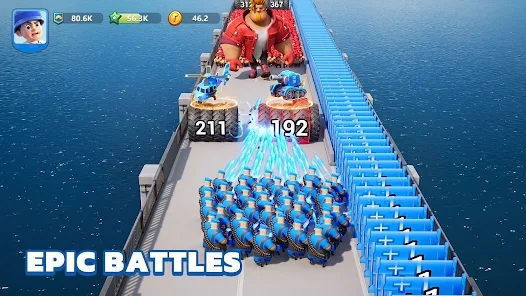Creative Casual Games: A Hidden Path to Mental Recharge
People often dismiss casual games as shallow distractions—something to mindlessly scroll through during a bus ride or between meetings. But what if these simple digital experiences actually hold a quiet power? Modern casual games aren’t just about passing time. When they lean into imagination, even for ten minutes, they reshape mental states. Consider the latest wave in creative games: intuitive worlds where logic loosens and whimsy takes over. Think building tiny gardens on floating clouds or orchestrating harmonies between singing trees.
In a world of tight deadlines and endless alerts, this low-effort escapism isn’t lazy—it’s a micro-sanctuary. The real genius lies in how frictionless they feel. No manuals. No steep learning curves. Tap. Drag. Bloom.
How Imagination-Focused Play Differs from Standard Gaming
Traditional gaming thrives on objectives—kill, win, reach. Creative games, on the other hand, are anti-goal. They don’t measure progress. Instead, they respond. They reflect. Like clay, you shape them without knowing the outcome. There's a tactile calmness, even through glass and sensors.
A few standouts blur the lines between digital toys and art:
- Tengami: A folded-paper world that glides with serene elegance.
- Alba: A Wildlife Adventure: Not a quest-driven map but a joyful catalog of creatures sketched by hand.
- Manifold Garden: Reality-bending architecture that challenges physics gently.
The absence of stress isn't accidental—it's architectural. These designs reduce cognitive strain, which research ties to improved mood resilience.
Why Stress Reduction is Built into Casual Mechanics
Not all relaxation comes from meditation cushions or silence. For many, tactile interaction—even digital tactile—is where tension leaks away. This is the overlooked brilliance of modern casual games: their rhythm mirrors mindfulness.
Fidget-spinner-level repetition? Maybe. But when each tap spawns color, growth, or music, the brain interprets this as subtle creation. A dopamine nudge. A soft affirmation: I made something, and it exists.
Unlike high-engagement games demanding constant vigilance, these prioritize atmosphere over anxiety. Sound palettes drift, visuals soften at edges, and failure—well, there isn’t any.
Deconstructing Clash of Clans 2 Games: Creativity Under Siege?
Now consider Clash of Clans 2 games. On surface, they look anything like the softness described above. Troop counts. Resource hoards. Enemy raids. But dig deeper, and a peculiar creative layer emerges—not in the combat, but in base design.
Players spend hours shaping fortress layouts like minimalist puzzles. Symmetry matters. Deflecting dragon flights becomes a geometry game. The creativity here is constrained—channeled through strategy—but deeply personal.
Still, these titles live on the edge of the relaxation spectrum. The thrill of a 3 a.m. raid might spark adrenaline, but not stillness. They represent a different flavor: constructive tension. Engaging? Absolutely. Tranquil? Less so.
It’s telling that players often turn to pure casual games *after* such sessions—to reset their neural circuitry. That transition reveals a natural hierarchy of digital needs.
| Game Type | Creativity Focus | Relaxation Factor | Interaction Mode |
|---|---|---|---|
| Creative Casual Games | High - Open-ended | High - No penalties | Exploration, building |
| Clash of Clans 2-Style Games | Medium - Strategic layout | Low - PVP pressure | Combat-driven |
| Idle Tappers | Low - Passive | Medium - Predictable rhythm | Mechanical input |
Nutritional Oddity: Can Potato Bread Go Bad in a Digital World?
Here’s where absurdity sneaks in. The keyword “can potato bread go bad" might feel jarringly concrete amidst a discussion of virtual landscapes. But consider the metaphor.
Physical food decays. Soft molds creep across bread left too long. Yet in digital realms? Ideas and creations don’t rot—they persist. A garden designed in a peaceful creative game may linger, untouched for months, but it doesn’t fester. There’s a permanence, however fragile in code, that comforts.
The irony? We worry over shelf lives of potato loaves yet rarely ask: do imaginative sparks expire? The right casual games say no. Even when unopened, their possibility remains.
Key Elements That Make Creative Casual Games Work for Mental Wellness
What ingredients create these gentle experiences? After reviewing dozens, certain patterns hold true. These critical elements keep appearing—not in rulebooks, but felt, moment by moment:
- Persistent environments: Your creation stays, even if you log out.
- No scoring systems: Progress isn’t judged, it’s experienced.
- Absorbing sensory loops: Soft sounds, evolving visuals.
- Daily “check-in" incentives: Light rewards—not punishment for absence.
- Sandbox freedom: Tools without fixed purposes.
The result? Players stop thinking in tasks. They enter “soft presence"—similar to doodling on a notepad, only glowing, responsive.
Conclusion: The Quiet Revival of Play Without Purpose
It’s ironic. In an age where productivity dominates discourse, some of the most meaningful digital interactions reject output entirely. The latest wave of creative games doesn’t seek to distract or dazzle. It seeks to soften.
For audiences in regions like Thailand, where communal calm remains culturally embedded yet challenged by urban rhythms, such games serve a silent role—they're digital counterparts to the sudden pause during songthaew travel, or the breath between temple visits.
And while Clash of Clans 2 games cater to conquest, it’s the low-stakes, imaginative casual games that may matter more for mental balance. They don’t need updates every month or esports leagues. They ask only to be touched—once, twice—and then to sit, alive, in the background of your life.
In a way, that’s the ultimate win condition. Not victory, but visibility. The ability to return anytime, to find your quiet world still growing… still possible.
Besides—if can potato bread go bad, perhaps we needed something that never spoils. Maybe that thing was digital play, all along.



